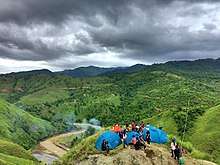Huishu
| Huishu | |
|---|---|
| Village | |
 Huishu Location in Manipur, India  Huishu Huishu (India) | |
| Coordinates: 25°14′46″N 94°33′07″E / 25.246°N 94.552°ECoordinates: 25°14′46″N 94°33′07″E / 25.246°N 94.552°E | |
| Country |
|
| State | Manipur |
| District | Ukhrul |
| Elevation | 1,699 m (5,574 ft) |
| Population | |
| • Total | 1,018 |
| Languages | |
| • Official | Tangkhul (Huishu Tui) |
| Time zone | UTC+5:30 (IST) |
| PIN | 795142 |
| Vehicle registration | MN |
| Nearest city | Ukhrul Imphal |
| Literacy | 87.91% |
| Lok Sabha constituency | Outer Manipur |
| Vidhan Sabha constituency | Chingai |
| Website |
manipur |
Huishu Village is situated on the northeast fringe of the District Headquarter, Ukhrul District, Manipur and is bordered by Myanmar in the northeast, Poi Village in the north, Chingai and Awang Kasom Ngahui in the Northwest, Kuirei village in the West and Khamasom village in the south. Huishu is called The green hills of rising sun and also " Northeast Indo-Myanmar corridor" of Manipur. The village is about 64 km from the district headquarter, Ukhrul and about 6 km from the pillar 125. Indo-Myanmar border. The village is partially connected by the national highway 150, Imphal-Kohima road via Jessami. The inhabitants speak Huishu dialect originated from the family of Tibeto-Burman language as well as Tangkhul language, a lingua franca of Tangkhul Naga Tribe. The mainland of the Village basically comprises three mountain ranges, namely SALIVI mountain in the east, Zingshan mountain in the West and the Wanchai river confluence range in the south. The great Zingshan mountain comprises two parallel ranges interspersed with Wangchai river confluence in the south extending up to Larang range bordering Khamasom village in the south through which immediately connects to SALIVI mountain range in the east and Loli range in the north which directly connects Huishu-Poi boundary through a narrow stream NARUKHU extending up to SALIVI mountain. The land is endowed with rich water and forest resources and is fertile,extensive and of great scenic beauty. Rambu hill, Ouhao hill, Zingshan mountain and Thurekakacho hill located on the right bank of the Huishu river are the main tourists destinations. The climate of Huishu Village may be broadly described as Sub-tropical monsoon type. The year's coldest months are December and January, when temperatures average around 10-15C while the hottest months are April and May. The best season for the tourists to visit the place is summer however, every season has its own flavour of beauty due to rich natural vegetation type and exotic beautiful landscapes. [1]
Total population

As per 2011 census,[2] Huishu has 201 households with the total of 1018 people of which 519 are male and 499 are female. Of the total population, 133 were in the age group of 0–6 years. The average sex ratio of Huishu village is 961 female to 1000 male which is lower than the state average of 985. The literacy rate of the village stands at 87.91%. Male literacy rate stands at 93.36% while female literacy rate was 82.22%.
People and occupation
The village is home to people of Tangkhul Naga tribe. Majority of the inhabitants are Christians. Agriculture is the primary occupation of the inhabitants. The village is well known in the district for its scenic beauty. Being close to the porous international boundary with Myanmar, the village served as the strategic transit point for militant groups to traverse between India and Myanmmar. Before the signing of the Cease-fire agreement between the NSCN (IM) and the Government of India in 2007, the village was burned down by the Indian Army as retaliation to attacks made on them by the militants on several occasions. The most devastating one being on 11 March 1996 carnage, when the whole village including the granaries were burnt to ground by the Indian arm forces after their camp was annihilated by the NSCN (IM). Some villagers were also reportedly shot dead both in custody[3] and in fake encounter[4] and many were tortured.[5]
References
- ↑ "On Huishu dialect". Research gate. Retrieved 2015-09-10.
- ↑ "Huishu Population". Census 2011. Retrieved 2015-09-10.
- ↑ "Custodial dead of Paisho from Huishu". Indian Kanoon. Retrieved 2015-09-10.
- ↑ "Justice after a decade". E-Pao. Retrieved 2015-09-10.
- ↑ "Human rights violation at Huishu" (PDF). Unipune. Retrieved 2015-09-10.